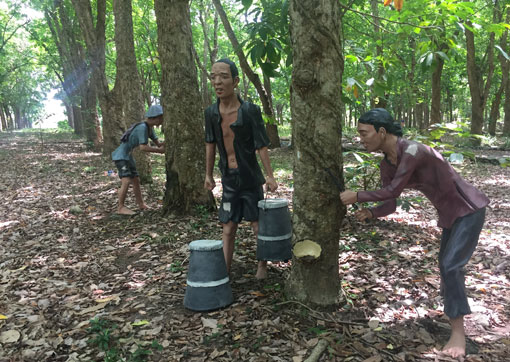A historic rubber plantation
Climate and soil in Dau Tieng have been very suitable for growing rubber trees. Thus in early years of the 20th century, the French came here to plant and exploit rubber trees... Nowadays, a rubber plantation from the French colonial period has become one of historical - cultural monuments of the province...

Daily works of rubber workers are re-enacted in this monument.

Guests visit traditional houses at the monument.
Rubber trees in the past
The rubber plantation of the French colonials is now Lot 50, village 14 of Tran Van Luu Rubber Farm of Dau Tieng Rubber Company. Experiencing the ups and downs of time, rubber trees here have quite big, rough foots, but leaves are still green. Knife cuts in the past are still visible on tree trunks. According to a representative of Dau Tieng Rubber Company, this rubber plantation was established by Michelin Rubber Company (France) in 1917. At first, the main labor force was local farmers. Due to the increasing demand for workers, Michelin Company recruited more women from northern and central provinces. By 1930, the number of workers here had reached nearly 1,000 and was on a rise. As labor force increased, the management also faced difficulties. Therefore, to facilitate the management, the French owners divided the plantation into 22 villages and managed harshly, inflicted cruelty upon rubber workers.
Labor abuse, regular violence, the harshness of forests made workers' lives of Dau Tieng rubber plantation in French colonial period was extremely miserable. Because of the lack of food, clothing, hard life, and even harsh treatment, rubber workers stood up to fight for their rights. These were strikes against plantation owners to demand 8-hour working days, bad meals, wages... The struggle reached its peak in March 1933, more than 2,000 workers carrying knives and sticks organized a strike and claimed their rights. The strike lasted for several days, rubber trees were not tapped, production activities were depressed. Then the plantation owners had to make concessions, promised to fulfill the demands of workers, such as: timely payment of wages, to offer enough daily ration of rice, not to beat workers... The initial victories of this struggle not only showed that the movement of rubber workers was growing, but also strengthened later struggling movements.
To preserve historical values
Time elapsed, many old rubber gardens were replaced with new, more productive rubber farms. In order to preserve historical values associated with Dau Tieng rubber, Dau Tieng Rubber Company has preserved the status quo of Lot 50, village 14. Up to now, this French-owned rubber plantation is over 100 years old. In April 2009, Provincial People's Committee issued a decision to recognize this rubber plantation as a historical monument at provincial level.
After this recognition, in October 2010, Dau Tieng Rubber Company started the construction of an exhibition area of rubber village under the French colonial period in this rubber plantation to serve tourists. After about 1 year of construction, the exhibition area was completed and put into service for visitors from May 2011.
The exhibition area is located in a rubber plantation established from the 1920s. It has many artifacts that are originals and recreated to serve visitors. The first impression as entering this monument is three houses for rubber workers (constructed around 1925-1935). After that, tourists move into a small latex processing plant which was a part and moved from main factory of the French. There is also a wood-chopping machine to take firewood to furnace. In addition, the exhibition area also has a display of valuable images and artifacts. In the rubber garden are figures of rubber workers standing tapping, carrying empty containers with rudimentary labor tools. Daily activities of former rubber workers are also vividly and closely recreated... Visitors are able to understand somewhat of the difficulties, hardships and suffering of rubber workers under the French domination time.
In addition to employees of Dau Tieng Rubber Company, in recent years, this relic also welcomed many delegations from inside and outside the province, people and students from schools. The re-enactment by images at this monument is a consciousness of respecting and preserving the revolutionary tradition of rubber working class here. Currently, the monument is maintained and managed by Dau Tieng Rubber Company. The construction of a French-owned rubber plantation as a historical site is of great significance in educating history for the next generations. This place not only is a demonstration of a historical period but also saves imprints of many national historical events, especially the development of revolutionary struggle movement of workers in rubber plantations against the French harsh regulation at that time.
Reported by Hong Thuan - Translated by Ngoc Huynh

